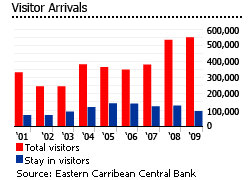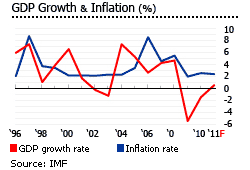Saint Kitts and Nevis: Emerging luxury property market
The property market in the Federation of St Kitts and Nevis remains vigorous, as the number of air flights into the islands increases.
The unspoiled islands of St Kitts and Nevis, with their excellent beaches and attractive landscape, are less expensive than most Caribbean islands, though real estate prices have been increasing since the early-2000s. Price rises slowed during the past two years due to the global crisis, but the upward movement did not halt.
A major draw is the citizenship-by-investment programme, which for a US$350,000 purchase of a unit in a pre-approved real estate development in St. Kitts or Nevis, plus cash payments of US$35,000 for the head of household, and US$15,000 for each additional family member, buys citizenship, the right to live and work in the Federation, visa-free access to the Schengen countries, and a large range of other benefits.

No official data on house price movements in St Kitts and Nevis exists; but reports from property developers and homebuyers suggest continued upward movement.
According to Coldwell Banker St. Kitts and Nevis Realty, property demand in St. Kitts and Nevis remains robust. While some banks have imposed stricter lending criteria, interest in home ownership is still strong, and lending institutions remain committed to financing in the housing market.
In the past four years the pace of real estate developments has increased rapidly – with some slowdown more recently - spurred by the arrival of the Marriott Hotel in Frigate Bay, and increased number of air flights into the islands. St. Kitts was ranked 4th on the British Airways’ top 10 holiday destinations for 2011.
“Since the Marriott opened, property sales and prices have increased dramatically,” says local real estate agent Brian Kassab.
The local housing market is expected to stay healthy in 2011, as the economy recovers and strong demand continues.
In Calypso Bay Resort, St. Kitts, resale prices of residential properties have quadrupled since the resort’s launch in 2001, says Ricky Pereira of St. Kitts Realty.
House and apartments can be expensive
Saint KittsIn February 2011, prices of residential properties in the Marriot Residences St Kitts range from XC$945,000 (US$350,000) for studio apartments to almost XC$5.4 million (US$2 million) for four-bedroom penthouses (the Eastern Caribbean dollar, the official currency of St. Kitts and Nevis, is pegged to the US dollar, at XC$2.7 to US$1).
However the Marriot is the top end of the range. In Ocean´s Edge, an exclusive residential development located in Frigate Bay, St. Kitts, property prices start at XC$958,500 (US$355,000) in February 2011, up 1.4% from two years ago.
On the other hand, unsold two-bedroom houses in the Silver Reef, a beautifully designed ‘green’ resort in St. Kitts, were priced from XC$1.2 million (US$445,000) to XC$1.26 million (US$465,000) over the same period.
In the Turtle Beach, an upscale residential area in St Kitts, plantation-style houses sell for about XC$2.5 million (US$950,000).
Another ambitious project, Christopher Harbour, is expected to lure foreign property investors. Christopher Harbour is a 2,500-acre project located in the southeastern coast of St Kitts. The starting price for villas and residences is rumoured to be at XC$2.7 million (US$1 million) per bedroom. Christopher Harbour will include a Tom Fazio golf course, a superyacht marina and a Mandarin Oriental hotel.
NevisIn the Sunset Ridge, situated near Mount Nevis, selling prices were unchanged from two years ago. The price of a Columbus model villa is XC$1.9 million (US$715,000), while a Nelson model is priced at XC$2.15 million (USD$795,000). The Phase 1 is expected to be completed by November 2011.
In Nelson Springs Beach Villas & Spas, located in Charlestown:
- One-bedroom units are priced at XC$1.2 million (US$450,000)
- two-bedroom units are sold for XC$1.49 million (US$550,000) to XC$1.76 million (US$650,000)
- four-bedroom units sell for around XC$3.51 million (US$1.3 million) to XC$4.32 million (US$1.6 million)
Solving housing problems
Till recently, many of the local population weren’t very well-housed. Prime Minister Denzil Douglas began to address the housing problems in St. Kitts and Nevis as soon as he took office in 1995.
About 2,500 affordable and middle-income homes have been built during the past 13 years via National Housing Corporation (NHC) programmes. About 800 homes are currently being constructed or renovated in St. Kitts. In Nevis, the Nevis Housing and Land Development Corporation (NHLDC) has embarked on a comprehensive home construction program to make affordable housing available.
Aside from affordable housing, the government is committed to raise housing standards.
“85% of the housing stock was damaged by Hurricane George in1998,” says Housing Minister Cedric Liburd. “In response, the government joined with USAID and the OAS…to create a plan of action for repair and upgrading of existing housing, so that these structures might be better suited to withstand future storms. The Parliament also upgraded the building codes in 2000.”
A recent study by the Caribbean Development Bank showed that poor quality housing in St. Kitts has been cut by 23% over the past 8 years. The percentage of population living in poor quality housing fell to 7.5% in 2008, as compared to 30.5% in 2000.
Citizenship-by-investment program
St. Kitts and Nevis’ Economic Citizenship Program has been in force since 1984, mainly to attract wealthy foreigners. By purchasing real estate in approved developments, the prospective expatriate (and his dependents) acquire citizenship instantly.
To qualify, the foreigner should satisfy the following:
- A minimum investment of XC$945,000 (US$350,000) in pre-approved real estate developments in St. Kitts and Nevis
- Payment of a cash sum of XC$94,500 (US$35,000) for the head of household and XC$40,500 (US$15,000) for each additional family member
APPROVED DEVELOPMENTS FOR ECONOMIC CITIZENSHIP |
||
| SAINT KITTS | NEVIS | |
| Calypso Bay Resort | Botanical Gardens | |
| Christophe Harbour | Bush Hill | |
| Golf View | Carino Hamilton Estate | |
| Half Moon Bay Villas | Cliffdwellers | |
| Heritage Plantation | Fern Hill Villa Development | |
| Horizons Villas | Fort Ashby Beach Club | |
| Kittitian Hill | Four Seasons Resort Estates | |
| Leeward Cove | Jones Estates and Red Hawk Ridge | |
| Marriot Vacation Club | Sunset Ridge (Live Nevis) | |
| Ocean’s Edge | Mount Nevis Hotel | |
| Pirate’s Nest | Nelson’s Springs Beach Villas and Spas | |
| Royal St. Kitts Hotel and Casino | Oualie Beach Resort | |
| Sea Lofts | Paradise Garden Estate | |
| Silver Reef Resort | Rawlins Plantation | |
| St. Christopher Club | Royal Getaway Estate | |
| Sundance Ridge | The Hermitage Plantation Inn Villas and Estates | |
| Sunrise Hill Resort | ||
The Economic Citizenship Program provides the following benefits:
- Full citizenship, for the applicant and all eligible family members
- Dual citizenship is permitted, without the requirement to notify the applicant’s home country, and without any need to reside in St. Kitts and Nevis
- Passports will be issued, and may be easily renewed
- Visa-free travel to more than 60 countries worldwide, including the Schengen Zone countries
- Full residency status and the right to work in St. Kitts and Nevis
- Tax free status on foreign income, capital gains, gift, wealth and inheritance tax
- As a Commonwealth citizen, the applicant receives preferential treatment in the UK (e.g. applicant’s children may enter the UK to study without the need to apply for student visas. After studying, they may work in the UK for 2 years without needing a work permit.)
Growing mortgage market

The mortgage market in St Kitts and Nevis grew to 29% of GDP in 2009, from an average of 26% of GDP from 2001 to 2008. Mortgage loans increased by 10.3% to XC$443.3 (US$164.2) million in 2009, according to the latest figures from the Eastern Caribbean Central Bank.
Foreign buyers still mostly pay cash, though local banks do offer home financing to non-residents. The maximum loan-to-value ratio is usually 60%, with loan terms of 15 years. Mortgage interest rates are typically tied to the US prime rate or LIBOR.
Foreign university students and workers form a stable rental market
Gross rental yields are low in St Kitts and Nevis, at around 3.7% to 3.8%, according to the January 2010 research by the Global Property Guide. This is consistent with a pattern of low rental yields over the years.
The long-term rental market, though small, is stable due to strong demand from non-resident workers and foreign students. St Kitts is home to two American universities.
Occupancy rates are difficult to determine and vary enormously, due to the influx of short-term vacationers during “season” from December to mid-April. Long-term rental apartments let for XC$3,240 (US$1,200) per month to XC$6,750 (US$2,500) per month, according to Coldwell Banker St. Kitts and Nevis Realty.
In Frigate Bay, two-bedroom houses command monthly rents from XC$2,160 (US$800) to XC$2,700 (US$1,000). In Ocean´s Edge, flats let for XC$4,860 (US$1,800) to XC$14,040 (US$5,200) per month.
Modest economic growth expected in 2011-12
In 2010, St Kitts and Nevis’s economy contracted by about 1.5%, after a 5.5% drop the previous year (IMF), largely due to decreased stay-over tourism, and less construction.
- In the private sector, construction of both tourism-related projects and residential properties has slowed.
- In the public sector, there was a low level of implementation of the Public Sector Investment Programme (PSIP), mainly due to financing constraints.

The economy is expected to recover in the next two years, with a projected GDP growth rate of 0.5% in 2011 and 1.5% in 2012.
St Kitts and Nevis’ economic growth rate averaged 4.2% during the period 1993 to 2008. However, the islands occasionally hit trouble. In 1998, hurricanes damaged about 85% of housing stock. In 2001, the 9-11 terrorist attacks in the US sapped economic growth.
Economic growth rose to 6.4% in 2006, mostly as a result of diversification into tourism and construction related to the Cricket World Cup. In addition, the government aggressively has promoted light manufacturing and international financial activities, to fill the gap left by the sugarcane industry.
Sugar used to be the backbone of the economy. However, decreasing world sugar prices prompted the government to close the sugarcane industry in 2005.